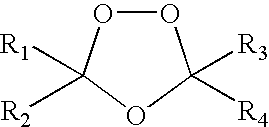Spiro and dispiro 1,2,4-trioxolane antimalarials
a trioxolane and antimalarial technology, applied in the field of compositions and methods for treating malaria, can solve the problems of inability to prevent disease recurrence, difficult treatment of malaria, and inability to cure malaria, etc., to achieve easy and inexpensive synthesizing, excellent potency and efficacy, and low degree of neurotoxicity
- Summary
- Abstract
- Description
- Claims
- Application Information
AI Technical Summary
Benefits of technology
Problems solved by technology
Method used
Image
Examples
example 1
General Procedure for the Preparation of 1,2,4-Trioxolanes
[0069]Synthesis of O-methyl 2-adamantanone oxime (representative procedure). To a solution of 2-adamantanone (4.51 g, 30 mmol) in methanol (30 ml) were added pyridine (4.5 ml) and methoxylamine hydrochloride (3.76 g, 45.0 mmol). The reaction mixture was stirred at room temperature for 48 h, concentrated in vacuo, and diluted with CH2Cl2 (50 ml) and water (50 ml). The organic layer was separated, and the aqueous layer extracted with CH2Cl2 (30 ml). The combined organic extracts were washed with 1M HCl (30 ml×2) and saturated aqueous NaCl (30 ml), and dried over MgSO4. Evaporation in vacuo afforded O-methyl 2-adamantanone oxime (4.77 g, 89%) as a colorless solid. mp 70-71° C.; 1H NMR (300 MHz, CDCl3) δ1.60-2.10 (m, 12H), 2.54 (s, 1H), 3.47 (s, 1H), 3.82 (s, 3H).
[0070]Ref: Corey, E. J.; Niimura, K.; Konishi, Y.; Hashimoto, S.; Hamada, Y. A New Synthetic Route to Prostaglandins. Tetrahedron Lett. 1986, 27, 2199-2202.
[0071]O-Methy...
example 2
Antimalarial Activity of OZ01-OZ369
Antimalarial Assays
[0092]Various OZ compounds were tested by the semiautomated microdilution assay against intraerythrocytic forms of Plasmodium falciparum derived from asynchronous stock cultures. The culture medium used was RPMI 1640 supplemented with 10% human type A+ serum, 25 mM HEPES, 25 mM NaHCO3 (pH 7.3). Human type A+ erythrocytes served as host cells. The culture was kept at 37° C. in an atmosphere of 3% O2, 4% CO2, and 93% N2 in humidified modular chambers.
[0093]Compounds were dissolved in DMSO (10 mg / ml), pre-diluted in complete culture medium, and titrated in duplicate in serial twofold dilutions over a 64-fold range in 96-well microtiter plates. After addition of the parasite cultures with an initial parasitemia (expressed as the percentage of erythrocytes infected) of 0.75% in a 2.5% erythrocytes suspension, the test plates were incubated under the conditions described above for 72 h. Growth of the parasites cultures was measured by ...
example 3
Onset of Action and Recrudescence of OZ11, OZ27, OZ78, OZ156, OZ175, OZ177, OZ207, OZ209, OZ277, and OZ279
Onset of Action and Recrudescence Experiments
[0098]The onset of drug action was determined after a single fixed dose of 100 mg / kg (SSV vehicle) po to groups of five animals on day +3 post-infection (day 0). Parasitemias at this point are usually between 25-40%. The infected controls do not survive beyond day +6 post-infection. The reduction of parasitemia is monitored 12, 24, and 48 h after treatment, and the time of recrudescence (>5% parasitemia) is assessed by daily blood smears for 14 days, followed by intermittent assessment for up to 60 days.
[0099]The onset part of this experiment reveals how rapidly a compound reduces parasite load; the recrudescence part of the experiment provides information about the efficacy of the compound against the parasite. A long delay in recrudescence can be due to a very good antiparasitic effect of the compound or to a compound with a long ha...
PUM
| Property | Measurement | Unit |
|---|---|---|
| Tm | aaaaa | aaaaa |
| Tm | aaaaa | aaaaa |
| temperature | aaaaa | aaaaa |
Abstract
Description
Claims
Application Information
 Login to View More
Login to View More - R&D
- Intellectual Property
- Life Sciences
- Materials
- Tech Scout
- Unparalleled Data Quality
- Higher Quality Content
- 60% Fewer Hallucinations
Browse by: Latest US Patents, China's latest patents, Technical Efficacy Thesaurus, Application Domain, Technology Topic, Popular Technical Reports.
© 2025 PatSnap. All rights reserved.Legal|Privacy policy|Modern Slavery Act Transparency Statement|Sitemap|About US| Contact US: help@patsnap.com



